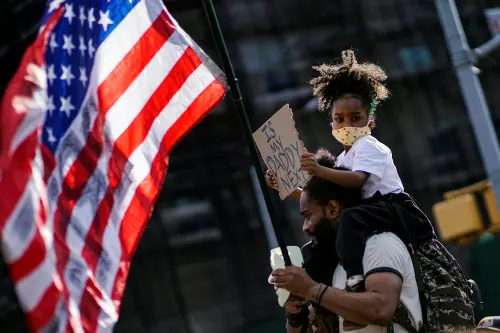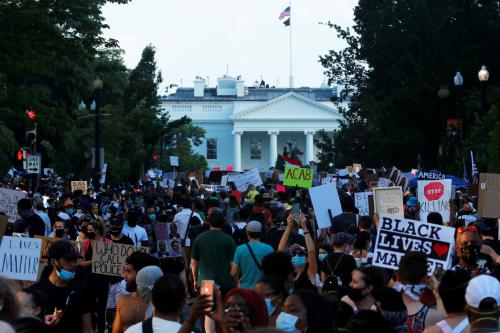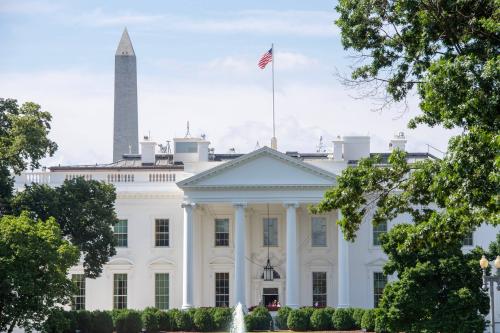“I’ve been poor my whole life, like a disease passing from generation to generation.” So says Toby Howard in the movie Hell or High Water. It is a poignant line. But one thing about the character makes the statement highly unlikely: he’s white. (Chris Pine plays the role).
In white families, poverty is almost never passed down “like a disease”. Our just-published paper shows that just 1.3% of whites are experiencing third-generation poverty. By comparison, more than one in five Black Americans (21.3%) are in the third generation of their family to be poor. (The full paper, co-authored with Scott Winship and Santiago Deambrosi of AEI as well as Christopher Pulliam and Ariel Gelrud Shiro from our own team, is “Long Shadows: The Black-white gap in multigenerational poverty”).
Our paper represents the first attempt to analyze income mobility patterns across three generations, back to the Civil Rights era, and it is an empirical challenge. But the overall pattern is starkly clear. Black Americans are sixteen times more likely to be in the third generation of poverty, defined as the bottom fifth of the income distribution (i.e. less than around $48,000 a year for a family of four in today’s money).
Time does not always heal
Why such a stark difference? The most obvious answer is that Black poverty rates were very high indeed half a century ago. Most 30-something Black Americans (59%) have a grandparent who was poor, compared to just nine percent of whites. But this is not just a matter of history. Even in more recent generations, the chances of being stuck in poverty are much higher for Blacks (especially Black men) than for whites. Blacks also face a much higher risk of downward mobility into poverty. Black poverty is much “stickier” across generations.
It is said that time heals. But it is now quite clear that time alone will not heal the brutal inequities experienced by Black Americans. Just as intentional public policy contributed to creating these gaps, so intentional public policy will be needed to close them. Here are five potential approaches that should be on the policy agenda:
- Transfer wealth to Black families
- End housing segregation
- Invest in education for Black students
- Support Black men
- Cut child poverty
- Transfer wealth to Black families
The racial wealth gap is wide – and as our colleague Bill Gale’s work shows, likely getting wider. Wealth is not income, but it both represents long-run income gaps, and can help to increase opportunity for our children, for example by helping with the costs of college, buying a car, or with a down payment on an apartment in a new city.
The moral case for reparations to Black Americans, as made by Ta-Nehisi Coates, Sandy Darity and Kirsten Mullen, and others, is unanswerable. The politics and practicalities may be a different matter; but on this, read our colleagues Rashawn Ray and Andre Perry. But our research shows clearly that a wealth transfer policy aimed at the multi-generationally poor would disproportionately benefit Black Americans, since they make up the overwhelming majority of this group.
Such an approach would be an example of what I have elsewhere described as a “race conscious policy”, occupying a middle ground between a race-based policy, such as straightforward reparations, and a so-called “race-blind” policy which does not consider racial differences in the impact of a policy. For example, Darity and Darrick Hamilton have also argued for “baby bonds” to children born to families with limited wealth.
- End housing segregation
Low-income Black Americans are very much more likely to live in areas of concentrated poverty, a reflection of the deep segregation of U.S. cities. Patrick Sharkey’s work shows that 62 percent of Black Americans born between 1955–1970 grew up in neighborhoods where at least a fifth of residents were poor, compared to just 4 percent of whites. Thirty years later, essentially nothing had changed. Two thirds (66%) of Black Americans born between 1985–2000 grew up in such neighborhoods, compared with just 6 percent of whites.
Land use regulations stand in the way of integration, especially in the form of “exclusionary zoning”, as work by our colleague Jenny Schuetz shows. At the same time, policymakers need to build in defenses against potential downsides of gentrification, as Jenna Davis argues.
- Invest in education for Black students
Education is strongly related to upward mobility, as a series of reports from Opportunity Insights, led by Prof Raj Chetty has shown. But the education system puts Black students at a disadvantage at every stage. Reform of K-12 funding is needed, as Sarah Reber and Nora Gordon argue. And there is much work to do at the post-secondary level, including further investments in HBCUs, as well as a concerted policy assault on the for-profit sector, which preys on students of color in particular. College completion rates for Black students are much lower than for others and a greater investment in proven strategies to promote retention, such as the ASAP program, is needed.
- Support Black men
The prosperity of Black families is hit hard by the combination of racism and sexism faced by Black men in particular. Previous work I conducted with Winship, and subsequent work by Chetty’s team, has shown that Black men have the lowest rates of upward mobility – much lower, in fact, than for Black women. As our colleague Camille Busette has written:
“To be male, poor, and either African-American or Native-American is to confront, on a daily basis, a deeply held racism that exists in every social institution. No other demographic group has fared as badly, so persistently and for so long.” To meet this “appalling crisis,” she calls for nothing less than “a New Deal for Black men.” Similarly Jhacova Williams argues on this blog that “A Black Brother needs love, too”.
This should include reform of the criminal justice system, action against the systematic exclusion of Black boys and men from educational institutions, tailored programs for college students, and much more. There is much work to do for the new – and vitally important – Commission on the Social Status of Black Men and Boys.
- Abolish child poverty
Although the focus of our new paper is on poverty over the long term, and by implication on the need to break the mechanisms through which poverty is passed from one generation to the next this does not preclude aggressive policy action to raise incomes at the bottom of the distribution here and now. In fact, reducing child poverty today is likely to help those children tomorrow, as Christopher Pulliam and I argue in support of the expanded child tax credit – and for making the expansion permanent. Monthly payments to qualifying families with children – $300 for each child under age 6 and up to $250 per month for those between ages 6 and 17 – will begin on July 15th. As we write “A direct cash transfer, then, can be both a powerful anti-poverty policy, and likely to be a pro-mobility policy, too: the policy equivalent of a two-fer.”
Intentional policy needed, now
This is of course not intended to be a comprehensive list, rather a sketch of a possible policy landscape. No doubt there are many more policies that could improve upward mobility for Black Americans. But one thing is clear. Breaking the cycle of multigenerational poverty means, above all, breaking the cycle of Black multigenerational poverty – and the systems that lie behind it.
The Brookings Institution is committed to quality, independence, and impact.
We are supported by a diverse array of funders. In line with our values and policies, each Brookings publication represents the sole views of its author(s).







Commentary
Time will not heal: 5 ways to address the inheritance of Black poverty, starting now
June 11, 2021